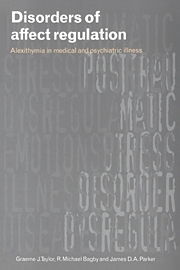Book contents
- Frontmatter
- Contents
- Foreword
- Acknowledgments
- Acknowledgment of permission for use of material
- Introduction
- 1 The development and regulation of affects
- 2 Affect dysregulation and alexithymia
- 3 Measurement and validation of the alexithymia construct
- 4 Relations between alexithymia, personality, and affects
- 5 The neurobiology of emotion, affect regulation, and alexithymia
- 6 Somatoform disorders
- 7 Anxiety and depressive disorders and a note on personality disorders
- 8 Substance use disorders
- 9 Eating disorders
- 10 Affects and alexithymia in medical illness and disease
- 11 Treatment considerations
- 12 Future directions
- Appendix
- References
- Index
8 - Substance use disorders
Published online by Cambridge University Press: 21 September 2009
- Frontmatter
- Contents
- Foreword
- Acknowledgments
- Acknowledgment of permission for use of material
- Introduction
- 1 The development and regulation of affects
- 2 Affect dysregulation and alexithymia
- 3 Measurement and validation of the alexithymia construct
- 4 Relations between alexithymia, personality, and affects
- 5 The neurobiology of emotion, affect regulation, and alexithymia
- 6 Somatoform disorders
- 7 Anxiety and depressive disorders and a note on personality disorders
- 8 Substance use disorders
- 9 Eating disorders
- 10 Affects and alexithymia in medical illness and disease
- 11 Treatment considerations
- 12 Future directions
- Appendix
- References
- Index
Summary
Alcoholism and drug abuse are major public health problems in many countries. In the United States, for example, it is estimated that 8–10% of men and 3–5% of women abuse or are dependent on alcohol, and that 5% of senior high school students consume alcohol on a daily basis (Bukstein, Brent & Kaminer, 1989; Group for the Advancement of Psychiatry, 1991; Schuckit, 1986). In 1985 there were over 500000 known heroin addicts in the United States, 5 million people were using cocaine, and at least 7 million were regularly using prescription drugs, mostly addictive ones, without medical supervision (Barchas et al., 1985).
The economic, social, and health consequences of psychoactive substance abuse are enormous. More than a decade ago, the estimated annual cost of alcohol and drug abuse to the economy of the United States was $177.4 billion (Group for the Advancement of Psychiatry, 1991). Substance abusers have high levels of morbidity and mortality from accidents and diseases, and also high prevalence rates of psychiatric disorders. In addition, the violent or other pathological behaviour of many substance dependent individuals frequently has adverse effects on the mental health of their spouses or children. Added to these sequelae in recent years is the rapid spread of HIV infection among intravenous drug users. Consequently, there is renewed interest in the treatment and prevention of substance use disorders with much of the current research focused on elucidating factors that increase peoples' risk for developing these disorders.
- Type
- Chapter
- Information
- Disorders of Affect RegulationAlexithymia in Medical and Psychiatric Illness, pp. 166 - 189Publisher: Cambridge University PressPrint publication year: 1997
- 3
- Cited by



